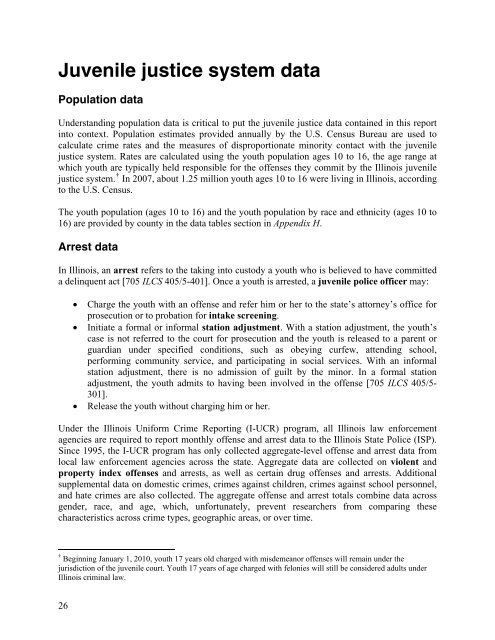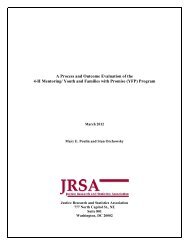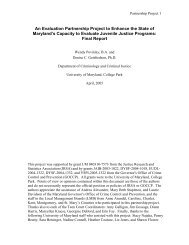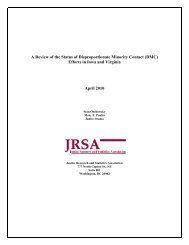Juvenile Justice System and Risk Factor Data - Illinois Criminal ...
Juvenile Justice System and Risk Factor Data - Illinois Criminal ...
Juvenile Justice System and Risk Factor Data - Illinois Criminal ...
Create successful ePaper yourself
Turn your PDF publications into a flip-book with our unique Google optimized e-Paper software.
<strong>Juvenile</strong> justice system data<br />
Population data<br />
Underst<strong>and</strong>ing population data is critical to put the juvenile justice data contained in this report<br />
into context. Population estimates provided annually by the U.S. Census Bureau are used to<br />
calculate crime rates <strong>and</strong> the measures of disproportionate minority contact with the juvenile<br />
justice system. Rates are calculated using the youth population ages 10 to 16, the age range at<br />
which youth are typically held responsible for the offenses they commit by the <strong>Illinois</strong> juvenile<br />
justice system. † In 2007, about 1.25 million youth ages 10 to 16 were living in <strong>Illinois</strong>, according<br />
to the U.S. Census.<br />
The youth population (ages 10 to 16) <strong>and</strong> the youth population by race <strong>and</strong> ethnicity (ages 10 to<br />
16) are provided by county in the data tables section in Appendix H.<br />
Arrest data<br />
In <strong>Illinois</strong>, an arrest refers to the taking into custody a youth who is believed to have committed<br />
a delinquent act [705 ILCS 405/5-401]. Once a youth is arrested, a juvenile police officer may:<br />
• Charge the youth with an offense <strong>and</strong> refer him or her to the state’s attorney’s office for<br />
prosecution or to probation for intake screening.<br />
• Initiate a formal or informal station adjustment. With a station adjustment, the youth’s<br />
case is not referred to the court for prosecution <strong>and</strong> the youth is released to a parent or<br />
guardian under specified conditions, such as obeying curfew, attending school,<br />
performing community service, <strong>and</strong> participating in social services. With an informal<br />
station adjustment, there is no admission of guilt by the minor. In a formal station<br />
adjustment, the youth admits to having been involved in the offense [705 ILCS 405/5-<br />
301].<br />
• Release the youth without charging him or her.<br />
Under the <strong>Illinois</strong> Uniform Crime Reporting (I-UCR) program, all <strong>Illinois</strong> law enforcement<br />
agencies are required to report monthly offense <strong>and</strong> arrest data to the <strong>Illinois</strong> State Police (ISP).<br />
Since 1995, the I-UCR program has only collected aggregate-level offense <strong>and</strong> arrest data from<br />
local law enforcement agencies across the state. Aggregate data are collected on violent <strong>and</strong><br />
property index offenses <strong>and</strong> arrests, as well as certain drug offenses <strong>and</strong> arrests. Additional<br />
supplemental data on domestic crimes, crimes against children, crimes against school personnel,<br />
<strong>and</strong> hate crimes are also collected. The aggregate offense <strong>and</strong> arrest totals combine data across<br />
gender, race, <strong>and</strong> age, which, unfortunately, prevent researchers from comparing these<br />
characteristics across crime types, geographic areas, or over time.<br />
† Beginning January 1, 2010, youth 17 years old charged with misdemeanor offenses will remain under the<br />
jurisdiction of the juvenile court. Youth 17 years of age charged with felonies will still be considered adults under<br />
<strong>Illinois</strong> criminal law.<br />
26

















